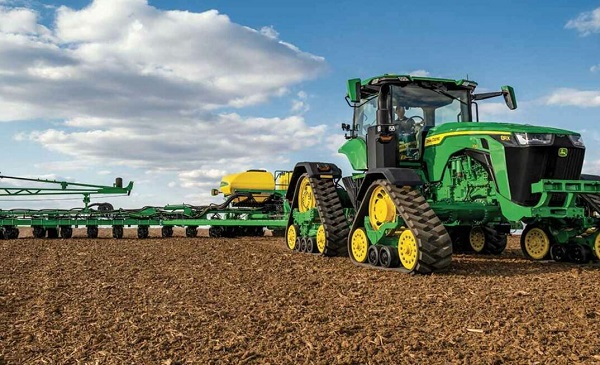When it comes to choosing between tires and tracks for farm machinery, several factors come into play.
Farmers today must consider not just the immediate cost, but also the long-term benefits and the specific requirements of their land. Each option has its advantages and disadvantages, and making the right choice can significantly affect productivity, fuel efficiency, and soil health.
In this article, we will explore the key differences between tires and tracks, helping you determine which option is best suited to your farm’s unique needs.
1. Traction and Ground Contact
One of the most important considerations when deciding between tires and tracks is traction and ground contact. Tracks typically offer superior traction, especially in challenging conditions such as wet, muddy, or hilly terrain. Their larger surface area distributes the machine’s weight more evenly, reducing the risk of slippage and providing greater stability.
On the other hand, tires, particularly those designed for agricultural use, are optimized to provide good traction in most conditions. However, they are more likely to sink or slip in soft, muddy, or loose soil. In dry conditions or on hard surfaces, tires often perform just as well as tracks, and their reduced rolling resistance can offer better fuel efficiency.
2. Soil Compaction
Soil compaction is a critical concern for farmers as it can affect crop yields by limiting root growth and water infiltration. Tracks, due to their larger surface area, exert less pressure on the soil, thereby minimizing compaction. This is especially important for farms with sensitive or heavy soils where compaction can have lasting negative effects.
Tires, while improving in design, typically cause more soil compaction, particularly when operating with heavy machinery. However, certain tire models with larger diameters and specialized tread patterns can help reduce this impact by spreading the load over a wider area. Air pressure adjustments can also help minimize compaction, but in general, tracks are better suited for farms concerned with soil health.
3. Maneuverability
When it comes to maneuverability, tires generally have an advantage. Wheeled machines can make tighter turns and navigate small or irregular fields more easily than tracked vehicles. This makes tires a better choice for farms with varied terrain, narrow pathways, or densely planted fields.
Tracks, while providing excellent stability and traction, require more space for turning and can be less nimble in confined areas. Additionally, tracked machines may experience more wear and tear when frequently operated on hard surfaces like roads, which is something to consider for farms that require frequent movement between fields.
4. Cost and Maintenance
Cost is often a deciding factor between tires and tracks. Initially, tires tend to be less expensive than tracks, both in terms of the equipment itself and the cost of replacement. Tires are also easier and cheaper to maintain. Punctures or damage can usually be repaired quickly and inexpensively, and tires can be replaced individually rather than as a whole set.
Tracks, while more expensive upfront, can offer savings in the long run due to their durability and extended lifespan in certain conditions. However, maintaining tracks requires specialized equipment and expertise. Replacement costs for tracks can also be high, and track systems often require more frequent servicing than tires to ensure optimal performance, especially when used in rough or rocky terrain.
5. Fuel Efficiency
Fuel efficiency is another key factor when choosing between tires and tracks. In many cases, tires offer better fuel efficiency on firm, even ground. Their lower rolling resistance means that machinery equipped with tires typically consumes less fuel, which can lead to significant savings over time.
Tracks, by contrast, tend to consume more fuel, particularly on hard surfaces or when used at higher speeds. The added friction and weight of a tracked system contribute to higher fuel usage. However, in situations where slippage is a concern (such as in wet or uneven fields), tracks may actually reduce fuel consumption by maintaining better traction and preventing unnecessary wheel spin.
6. Versatility
When it comes to versatility, tires generally outperform tracks. Machines with tires can be used on a wide variety of surfaces, including paved roads, gravel paths, and fields. This makes them ideal for farms that require transportation between fields or to markets. Additionally, tires are easier to change based on seasonal needs or terrain, offering more flexibility for diverse farming operations.
Tracks are less versatile, particularly when used on hard or paved surfaces where they can wear down quickly. They are best suited for farms that operate primarily in fields with soft soils or challenging terrain. However, recent advancements in track design are improving their adaptability for mixed-use environments, making them a more attractive option for some farmers.
Conclusion: Which is Best for Your Farm?
Ultimately, the choice between tires and tracks depends on your farm’s specific conditions and operational needs. Tracks are ideal for farms with soft, uneven, or muddy terrain, as they provide superior traction, reduce soil compaction, and enhance stability in difficult conditions. For farms concerned with soil health or operating in challenging environments, the benefits of tracks may outweigh their higher upfront cost and maintenance requirements.
Tires, on the other hand, offer better maneuverability, fuel efficiency, and versatility, particularly for farms with firm soil, hard surfaces, or narrow fields. They are also more cost-effective to maintain, making them a practical choice for many farmers.
In summary, both options have their place in modern agriculture, and your decision should be based on the type of land you manage, your machinery’s usage patterns, and your long-term farming goals. By carefully evaluating these factors, you can select the option that maximizes efficiency and productivity for your farm.
Also Read
Continental unveils largest tractor tire
Goodyear Farm Tires creates Low Sidewall Technology centre in France
